In 2000, golden rice became the first genetically modified (GM) crop designed with the goal of improving human health by providing provitamin A, a nutrient that is lacking in the diet of 250 million children and whose deficiency can cause everything from blindness to complications leading to death. However, pressure from anti-transgenic groups and indecision on the part of governments have hampered the introduction of these crops into the countries that would benefit most from them. But in the meantime, with much less fanfare, the same technology has been applied to the creation of other golden varieties of staple foods that could find their way to market sooner than golden rice.
Golden banana
As Jean-Yves Paul, a plant biotechnologist at Queensland University of Technology, explained to OpenMind: “Rice is useful in South East Asia because it is consumed in large amounts, but would not be as effective in other places where people use a different staple.” Thus, other regions of the world need different crops more suited to local needs. And that is where the golden banana comes in, created by Paul and his collaborators under the direction of James Dale. “In Uganda the main staple is the East African highland banana (a cooking banana) hence this is the target crop of the Banana21 project,” says Paul. “Golden bananas will be effective in East Africa as they are an integral part of the diet.”
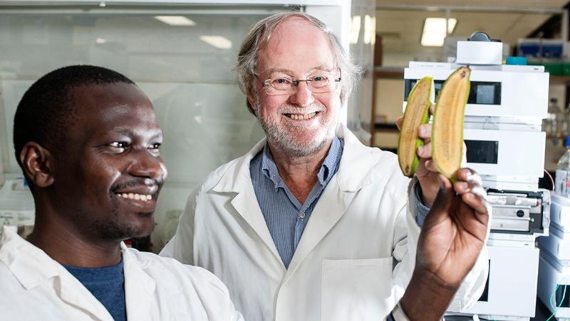
The ten-year project has received financial support of $10 million from the Bill & Melinda Gates Foundation and the UK government. Unlike golden rice, in which a gene from maize was inserted, the golden banana incorporates a gene from another wild variety of the same plant, but which is native to New Guinea and does not form large bunches, so it is not suitable for cultivation. Researchers tested the crop in Australia before moving the project to Uganda to introduce the gene into local bananas. “We have made a point over the years to make sure these bananas are made in Uganda, by Ugandan scientists for the benefit of Ugandans,” says Paul.
However, how the golden banana will manage to overcome the regulatory process remains an open question. “In the case of Uganda, the regulatory framework is in its infancy and time will tell how golden bananas and other GM crops will go through the process of deregulation,” says Paul, who is confident that “this approach will certainly help in creating the regulations and building public confidence in this technology and its benefits.” In fact, among the various golden foods in development, the banana has generated great expectations among experts: “If I had to bet, I’d go for the golden banana,” plant biotechnologist José Miguel Mulet, from the Polytechnic University of Valencia, told OpenMind.
Multi-vitamin corn
Although corn naturally produces provitamin A or beta carotene, its content of this essential nutrient is highly variable, and even the most yellowish colour of the kernals is not a guarantee of high quantity. Therefore, researchers cross traditional varieties to try to obtain biofortified lines with a more abundant and homogeneous amount of this compound. But in this field too, genetic engineering technologies are a useful option for providing varieties richer in provitamin A.
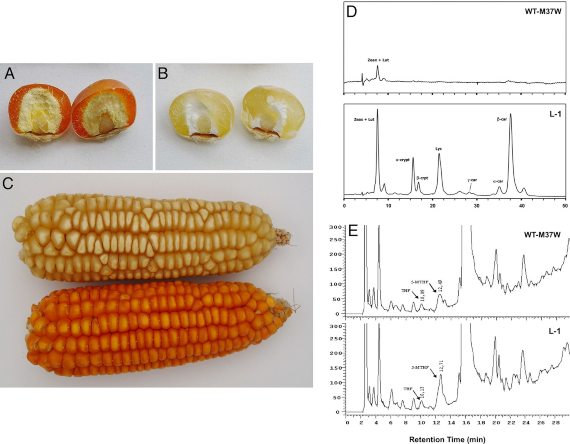
Among the projects underway to achieve this goal, one that stands out is being led by the University of Lleida (Spain), whose research has produced a GM corn crop with three metabolic routes modified to increase not only the beta carotene content, but also ascorbate (vitamin C) and folate (vitamin B9). The result is a superfood that increases the normal levels of beta carotene in maize by a factor of 169, together with ascorbate and folate contents that are respectively six times and twice the usual amounts of these vitamins in this cereal. According to the researchers, this achievement “vastly exceeds any realised thus far by conventional breeding alone” and “opens the way for the development of nutritionally complete cereals to benefit the world’s poorest people.”
Golden potato
As the fourth most widely consumed plant food worldwide, the potato seems to be another clear candidate for nutrient supplementation through genetic modification. Mankind’s favourite tuber—the staple food of more than 800 million people—is well supplied with vitamin C, but is very deficient in beta carotene, so in this case the classic technique of cross-breeding varieties is not enough.
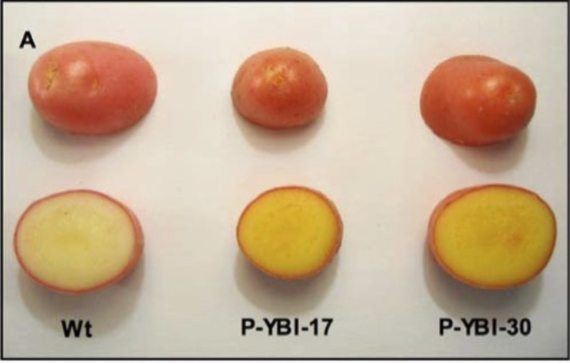
In 2007, a team of researchers from Italy’s Ente per le Nuove Tecnologie, l’Energia e l’Ambiente (ENEA), with the collaboration of Peter Beyer, co-creator of golden rice at the University of Fribourg, introduced into potatoes a small metabolic circuit derived from bacteria, identical to that used in golden rice, to give them the ability to produce carotenoids. The potato thus became the third golden crop obtained, after rice and corn, boosting the beta-carotene content of the original product by a factor of 3,600 and surpassing the improved version of golden rice. Subsequent studies by ENEA and Ohio State University, which have simulated in vitro the digestion of the food cooked, have shown that a 150 gram portion of these golden potatoes can provide 42% of a child’s daily requirement of vitamin A and 34% of that of vitamin E.
Biofortified cassava
Cassava (Manihot esculenta) is a staple crop for more than 250 million people in Africa, and is also widespread in parts of Asia and Latin America. However, as its main energy source comes from carbohydrates, it is totally insufficient for a proper diet, providing less than 30% of daily protein needs, and only 10%-20% of iron, zinc and vitamin A requirements. This is compounded by the presence of cyanide, which can be dangerous if the tubers are not properly prepared.
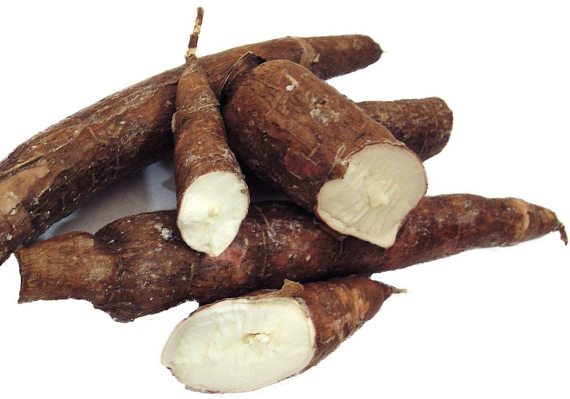
In 2004, the Bill & Melinda Gates Foundation funded the BioCassava Plus programme, with the aim of obtaining transgenic varieties of higher nutritional quality and with a reduced cyanide content. In 2007, field trials began in Puerto Rico, followed by further trials in Nigeria and then Kenya. Since 2012, the Gates Foundation has also been supporting a project to optimise cross-bred varieties.
Golden wheat
Wheat occupies more farmland in the world than any other plant food, and therefore the breeding of biofortified varieties to produce more beta carotene has also been a goal of interest.
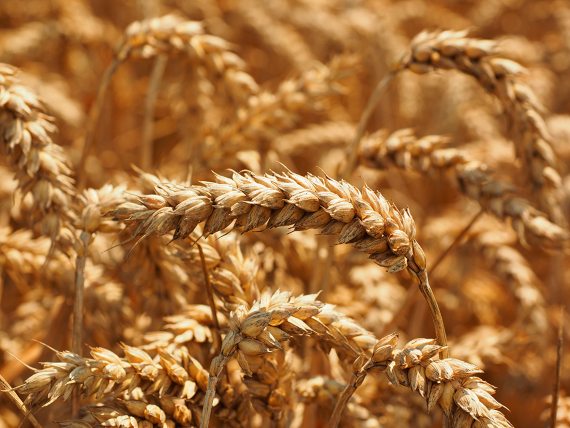
The strategy used to obtain golden rice was applied in 2009 at Huazhong University of Science and Technology (China) to create a wheat variety with ten times more carotenoid content than the original grain. The same technique has also been applied to sorghum, a cereal of immense importance in the diet of large regions of the Americas, Africa and South Asia, as well as to tomatoes.
Golden orange
The orange is an example of how progress in research is finding new ways to improve food by genetic techniques. In 2014, scientists from the Valencian Institute of Agricultural Research obtained a variety of oranges with 36 times more beta carotene in the flesh, by genetically inhibiting an enzyme that degrades this compound in the original fruit. Using tiny Caenorhabditis elegans worms as model consumers of this new variety, the researchers showed that the golden orange has a 20% greater antioxidant effect than the non-GM fruit. According to the authors, their work “demonstrates the potential of genetic engineering for the nutritional enhancement of fruit crops.”
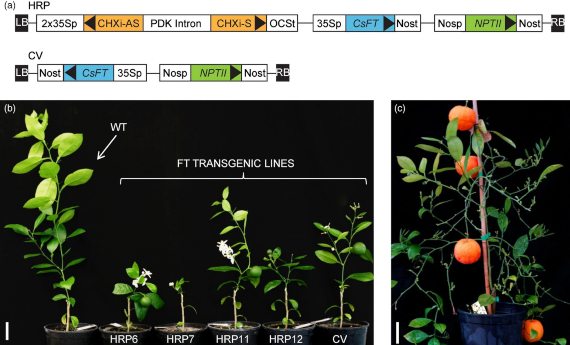
Comments on this publication